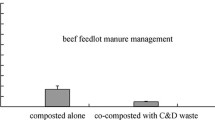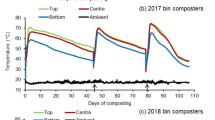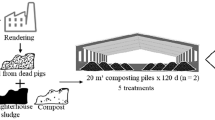Abstract
Following outbreaks of bovine spongiform encephalopathy (BSE), fewer cattle mortalities are being rendered. Composting may be a viable on-farm alternative for disposal of cattle carcasses. A study was conducted to assess feasibility and greenhouse gas (GHG) emissions during co-composting of cattle mortalities and manure. Using a tractor-mounted front-end loader, windrows were constructed containing manure + straw (control; CK) or manure + straw + cattle mortalities (cattle mortality; CM). The composting process lasted 310 d. The windrows were turned twice, at days 93 and 211, using either a tractor-mounted front-end loader or a specialized shredder bucket. Maximum windrow temperatures were >50 °C for 36 out of 92 d (before first turning) and 142 out of 208 d (after first turning) for the CM treatment and cattle mortalities were completely decomposed except for a few large bones. The cumulative CO2 and CH4 emissions were significantly affected by the mortality treatment, but not by the turning technology or their interactions. Significantly higher CO2 (53.6 g d−1 m−2) and CH4 (2.204 g d−1m−2) emissions were observed during the co-composting of cattle mortalities than manure composted with straw (23.0 and 0.742 g d−1m−2 for CO2 and CH4, respectively). Similarly, N2O emissions were higher with mortalities than without and, for the CM treatment only, higher with shredder bucket than front-end loader turning. In the final compost, CM had higher TN and NH +4 -N contents than CK while TC and the C/N ratio were higher with compost turned with the front-end loader than with the shredder bucket. In conclusion, composting was an effective means of disposing of cattle mortalities, but did increase GHG emissions and the N content in the final compost. It is not known if GHG emissions are different than those that would be released from natural decomposition of carcasses. The higher N content in compost containing mortalities would increase its agronomic value.







Similar content being viewed by others
References
Bagley CV, Kirk HJ, Farrell-Poe K (1999) Cow mortality disposal. AG-507. Utah State University Extension, Logan, UT
Beck-Friis B, Pell M, Sonesson U, Jönsson H, Kirchmann H (2000) Formation and emission of N2O and CH4 from compost heaps of organic household waste. Environ Monit Assess 62:317–331
Berg RT, Butterfield RM (1976) New concepts of cattle growth. Sydney University Press, University of Sydney, p 240
Eghball B, Power JF, Gilley JE, Doran JW (1997) Nutrients, carbon, and mass loss during composting of beef cattle feedlot manure. J Environ Qual 26:189–193
Environment Canada (2004) Canada’s 2004 Greenhouse gas inventory A Summary of Trends. http://www.ec.gc.ca/pdb/ghg/inventory_report/2004/2004summary_e.cfm
Environment Canada 2006. Available online at: http://www.climate.weatheroffice.ec.gc.ca/advanceSearch/searchHistoricDataStations_e.html
Fonstad TA, Meier DE, Ingram LJ, Leonard J (2003) Evaluation and demonstration of composting as an option for dead animal management in Saskatchewan. Can Biosys Eng 45(6):619–625
Fukumoto Y, Osada T, Hanajima D, Haga K (2003) Patterns and quantities of NH3, N2O and CH4 emissions during swine manure composting without forced aeration—effect of compost pile scale. Bioresour Technol 89:109–114
Fulhage C, Ellis CE (1996) Composting dead swine. WQ 351. University of Missouri Extension, Columbia, MO
Genaille D, Chen Y, Doan V (2005) Effect of carbon amendment on the temperature during composting of cattle mortalities. CSAE/SCGR 2005 Annual Meeting. Winnipeg, MB, Canada. June 26–29, 2005 Paper No. 05-078 http://www.bioeng.ca/Papers/2005/CSAE%20papers/05-078.pdf (last accessed on July 20, 2006)
Glanville T (1995) Composting dead livestock: a new solution to an old problem. SA-8. Iowa State University Extension, Ames, IA
Hao X, Chang C, Larney FJ, Travis GR (2001) Greenhouse gas emissions during cattle feedlot manure composting. J Environ Qual 30:376–386
Hao X, Chang C, Larney FJ (2004) Carbon, nitrogen balances and greenhouse gas emission during cattle feedlot manure composting. J Environ Qual 33:37–44
Hutchinson GL, Mosier AR (1981) Improved soil cover method for field measurement of nitrous oxide fluxes. Soil Sci Soc Am J 45:311–316
Keener HM, Elwell DL, Monnin MJ (2000) Procedures and equations for sizing of structures and windrows for composting animal mortalities. Applied Eng Agric 16:681–692
Langston JD, VanDevender CK, Boles JC (1997) Disposal of swine carcasses in Arkansas. MP 392. University of Arkansas Extension
Larney FJ, Yanke LJ, Miller JJ, McAllister TA (2003) Fate of coliform bacteria in composted beef cattle feedlot manure. J Environ Qual 32:1508–1515
Lawson MJ, Keeling AA (1999) Production and physical characteristics of composted poultry carcasses. Br Poul Sci 40:706–708
Loneragan GH, Dargatz DA, Morley PS, Smith MA (2001) Trends in mortality ratios among cattle in US feedlots. J Am Vet Med Assoc 219:1122–1127
Looper M (2002) Whole animal composting of dairy cattle. Guide D-108. New Mexico State University, Las Cruses, NM
Mukhtar S, Auvermann BW, Heflin K, Boriack CN (2003) A low maintenance approach to large carcass composting. Written for presentation at the 2003 ASAE Annual International Meeting. Las Vegas, NV. July 27–30
Murphy JP, Harner JP, Strahm T (2004) Composting Cattle Mortalities. 2004 ASAE/CSAE Annual International Meeting. Ottawa, ON, Canada. August 1–4
Stanford K, Larney FJ, Olson AF, Yanke LJ, McKenzie RH (2000) Composting as a means of disposal of sheep mortalities. Compost Sci Util 8:135–146
Stanford K, Nelson V, Sexton B (2005) Open-air windrows for winter disposal of large animal mortalities: effects of ambient temperature and windrow dimensions. American Society of Animal Science Annual Meeting. Cincinnati, OH. July 23–28
VanDevender K, Pennington J (2004) Organic burial composting of cattle mortality. FSA1044. University of Arkansas Cooperative Extension Service. Little Rock, AR
Van Herk FH, Cockwill CL, Guselle N, Larney FJ, Olson ME, McAllister TA (2004) Elimination of Giardia cysts and Cryptosporidium oocysts in beef feedlot manure compost. Compost Sci Util 12:235–241
Yamulki S (2006) Effect of straw addition on nitrous oxide and methane emissions from stored farmyard manures. Agric Ecosyst Environ 112:140–145
Zhang Y, He Y (2006) Co-composting solid swine manure with pine sawdust as organic substrate. Bioresour Technol 97:2024–2031
Acknowledgements
This project was funded by the Agriculture and Agri-Food Canada’s Environmental Technology Assessment for Agriculture (ETAA) Program. Technical assistance was provided by G. Travis, B. Hill, P. Caffyn, A. Olson, G. Wallins and H. Zahiroddini. The authors also acknowledge P. Morrison of Roseburn Ranches, High River, AB for granting access to their premises, supplying all materials, and constructing and maintaining composting windrows. This is Lethbridge Research Center Contribution 38706040.
Author information
Authors and Affiliations
Corresponding author
Rights and permissions
About this article
Cite this article
Xu, S., Hao, X., Stanford, K. et al. Greenhouse gas emissions during co-composting of cattle mortalities with manure . Nutr Cycl Agroecosyst 78, 177–187 (2007). https://doi.org/10.1007/s10705-006-9083-1
Received:
Accepted:
Published:
Issue Date:
DOI: https://doi.org/10.1007/s10705-006-9083-1




